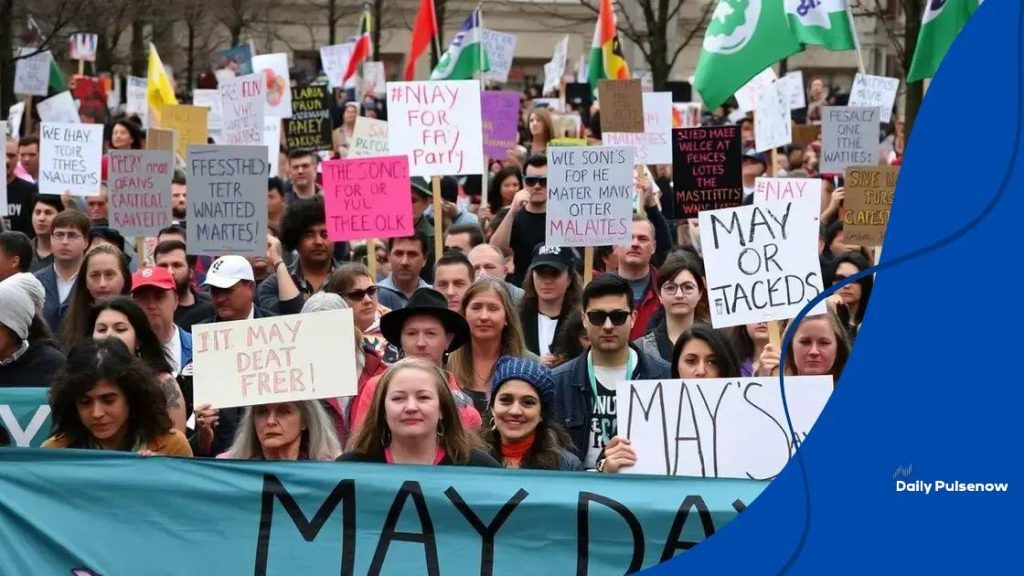May Day protests spread nationwide and ignite change

Anúncios
May Day protests spread nationwide to advocate for labor rights, raise awareness on wage inequality, and prompt government action, significantly impacting public opinion and promoting social justice.
May Day protests spread nationwide, capturing the attention of millions across the country. These rallies not only seek justice but also inspire conversations about workers’ rights and social equality. What does this mean for our future?
Anúncios
Understanding the origins of May Day protests
Understanding the origins of May Day protests is crucial to grasp the significance of these events today. May Day, celebrated on May 1st, has deep historical roots linked to labor movements and the fight for workers’ rights.
The Historical Context
Originally, May Day marked the celebration of spring in various cultures. However, as industrialization grew in the 19th century, it transformed into a symbol of labor rights activism. The Haymarket Affair in Chicago in 1886, which called for an eight-hour workday, was pivotal in this shift. The protests ended tragically with violence, but they solidified the date as a day of remembrance for workers’ struggles.
Key Events That Shaped May Day
Several crucial events contributed to the movement’s evolution:
Anúncios
- The establishment of International Workers’ Day in the late 19th century.
- Rallies across Europe advocating for labor rights.
- American labor unions embracing May Day to promote workers’ solidarity.
As May Day grew in recognition, countries around the world began adopting it as a day of protest for labor rights. In places like the United States, it became an opportunity to voice concerns about worker exploitation and demand fair treatment.
Today, May Day protests serve as a platform to address not just labor issues but also broader social justice concerns. Issues like wage equality, workers’ safety, and immigrant rights frequently feature in these demonstrations.
Key issues raised during nationwide demonstrations
Nationwide demonstrations during May Day protests focus on critical issues that resonate with many people today. These protests highlight ongoing struggles for workers’ rights and social justice, drawing attention to various concerns faced by communities across the country.
Wage Inequality
A significant issue raised during these demonstrations is wage inequality. Many protestors advocate for fair wages that reflect the cost of living. Despite years of economic growth, many workers still struggle to make ends meet.
Workers’ Rights
Workers’ rights are often at the forefront of protests. The demand for better working conditions, safe work environments, and reasonable hours is echoed across various industries. Protesters emphasize the importance of unions and collective bargaining in securing these rights.
Immigrant Rights
Immigrant rights also receive significant attention during May Day protests. Activists advocate for policies that protect immigrant workers from exploitation and discrimination. They call for comprehensive immigration reform that provides pathways to citizenship and ensures fair treatment for all.
- Access to healthcare for all workers.
- Support for marginalized communities seeking equality.
- Environmental justice as it relates to labor practices.
The presence of various advocacy groups during these protests highlights the interconnectedness of these issues. The fight for social justice encompasses not just labor rights but also civil rights, environmental concerns, and more. Ultimately, these demonstrations symbolize hope and the collective demand for a fairer society.
Responses from government and organizations

The responses from government and organizations during and after the May Day protests are crucial in shaping the narrative around labor rights. Different entities often react in various ways, reflecting their views on the demands raised by demonstrators.
Government Responses
Typically, government responses can range from supportive to dismissive. Some officials recognize the significance of worker movements and vow to address issues like wage inequality and worker protections. Others may downplay the protests, suggesting that the demands are unrealistic or too radical.
Policy Proposals
In response to growing public pressure, governments might propose new policies aimed at addressing protesters’ concerns. For example, they may introduce:
- Minimum wage increases to match living costs.
- Stricter regulations for workplace safety.
- Programs to aid unemployed workers.
These measures demonstrate an acknowledgment of the issues raised but often receive mixed reviews from protestors who may feel these actions are insufficient.
Organizational Reactions
Labor unions and advocacy groups also have significant roles during these events. They often collaborate with protestors to ensure that the message remains unified. Many organizations issue statements supporting the causes, calling for sustained activism to keep momentum going. They may also provide resources and assistance to help protestors organize.
Additionally, some organizations might mobilize to counter the protests, arguing that certain demands could harm the economy or job market. This can lead to public debates on the effectiveness of labor movements in contemporary society.
The dialogue that arises from these responses is vital in understanding the broader implications of May Day protests. It illustrates the complexities of achieving change within systems that may resist reform.
Impact of protests on public opinion
The impact of protests on public opinion during May Day protests is significant. These events often shift the way people view labor rights and social justice issues. When large crowds take to the streets, it brings attention to the challenges workers face and encourages discussions in communities and online.
Shaping Perceptions
Protests can change perceptions about what people consider acceptable in terms of wages and working conditions. As demonstrators share their stories and demands, they can foster a sense of urgency regarding these issues. For many, seeing the determination of protestors inspires increased awareness and empathy for those affected by labor injustices.
Media Coverage
The role of the media is crucial in shaping public opinion. News reports, social media posts, and live streams of protests help spread the messages and demands of the demonstrators. Positive coverage can galvanize support, while negative portrayals may discourage participation.
Dialogue and Discussion
Protests often generate conversations among friends and family, leading to greater engagement on issues like wage inequality and workers’ rights. Social media platforms play a significant role in this dialogue, as hashtags and posts can reach a wide audience.
As public interest grows, policymakers may feel pressure to address the issues raised. This can lead to legislative changes as officials seek to align themselves with constituents who are increasingly aware of and concerned about labor rights.
Overall, the impact of protests on public opinion is multifaceted, influencing not just individual beliefs but also the broader societal context surrounding labor and social justice movements.
Future implications for labor rights
The future implications for labor rights are increasingly shaped by the ongoing discussions and actions arising from May Day protests. As society grapples with economic changes and social justice movements, the landscape of labor rights continues to evolve.
Adapting to Technological Changes
One major consideration for the future is how technology impacts labor markets. Automation and artificial intelligence are changing the nature of work, which raises questions about job security. Protests highlight the need for policies that protect workers in industries that are rapidly changing.
The Role of Legislation
Future labor rights may hinge on legislative measures proposed in response to sustained activism. Laws aimed at protecting gig and freelance workers are gaining traction. Possible changes could include:
- Expanding benefits for part-time workers.
- Strengthening protections against workplace discrimination.
- Ensuring living wages for all workers.
Activism will likely continue to play a critical role in pushing these issues into the public eye. As communities organize and raise their voices, they influence not only public perception but also political will.
Global Solidarity
Future labor rights will also be affected by global solidarity among workers. As movements like the May Day protests grow internationally, there is a chance for increased collaboration. Workers from different countries can unite to combat common challenges posed by multinational corporations.
This solidarity can lead to more substantial pressure for fair labor practices globally, reinforcing the idea that labor rights are human rights.
As these conversations continue and evolve, the future of labor rights promises to be dynamic and potentially transformative. The collective efforts of activists and organizations will be vital in shaping this future.
The ongoing May Day protests continue to play a pivotal role in shaping public awareness and action regarding labor rights. As communities come together, they raise important issues like wage inequality, workers’ rights, and social justice. These protests not only influence public opinion but also challenge lawmakers to take action. Ultimately, the future of labor rights relies heavily on the collective power of protestors and their ability to unite for common causes. With growing global solidarity, the movement aims to ensure that labor rights are recognized as fundamental human rights for everyone.
\n\n\n
\n
\n
FAQ – Frequently Asked Questions about May Day Protests and Labor Rights
What are the main goals of the May Day protests?
The main goals include advocating for workers’ rights, addressing wage inequality, and promoting social justice.
How do May Day protests impact public opinion?
These protests raise awareness about labor issues and can shift public perceptions, encouraging discussions on worker rights.
What role do governments play during May Day protests?
Governments may respond with policies aimed at addressing the concerns raised, but responses can vary from supportive to dismissive.
Why are labor rights considered human rights?
Labor rights are fundamental to ensuring fair treatment, safe working conditions, and equity in the workplace for all individuals.